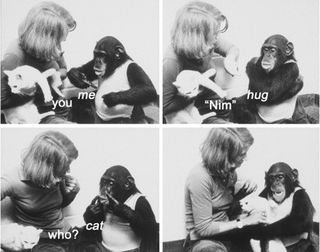What Reason Might Noam Chomsky Give To Explain Why It Is So Difficult To Teach Language To Animals?
40 years ago, I published an article, "Can a Chimpanzee Create a Judgement?" My respond was, definitively, "No." At the time, that conclusion was controversial. It was besides headline news because other psychologists had claimed that chimpanzees did, in fact, accept some linguistic power.
Why were I and other psychologists concerned about the linguistic abilities of a chimpanzee? The reason was very simple. Post-obit B. F. Skinner's lead, behaviorists thought that human being'due south utilise of language could exist explained equally conditioned behavior. I was i of those behaviorists. If Skinner were right, why non status our most intelligent living ancestor to learn linguistic communication?
Noam Chomsky challenged that view and argued that language was uniquely man. Evidence to the contrary would be significant considering it would question Darwin'southward view that linguistic communication, similar all other intellectual abilities, evolved. If language didn't evolve, by what other means did information technology announced?
Attempts to teach chimpanzees to use speech all faced the same problem: a chimpanzee'south poorly adult articulatory apparatus. Chimpanzees are unable to produce the sounds (phonemes) that comprise human language. (In this blog I will only accept room to draw attempts to teach American Sign Linguistic communication, or ASL, a gestural language used by hundreds of thousands of deaf people. Every bit I will explicate in my next blog, still, my conclusions almost a chimpanzee's inability to learn ASL besides use to all other attempts to teach animals to use language.)
On my project, I worked with an baby male chimpanzee I named Nim Chimpsky. He was raised in a New York townhouse by a family who knew sign language and was also taught to sign by volunteers. Nim learned his start sign, drinkable, when he was four months old.

Source: Herbert Terrace
During the side by side 3 and a half years, he had learned 127 other signs. Most surprising was his "spontaneous" ability to combine signs into simple sentences. For example, in the photos shown below, Nim is signing hug cat in order to play with a cat.
That and other combinations that Nim produced were the ground of the article I submitted to Scientific discipline, in which I claimed that a chimpanzee could create a sentence. As evidence, I included the above photos. But a shocking discovery led me to withdraw the paper while information technology was under review. While observing slow-motility videotapes of Nim interacting with his teachers. I noticed that nearly of his signs were prompted by his teachers.
When I observed Nim signing, I realized that I was looking at him through a self-imposed telephoto lens. That was likewise true of his teachers and of a review console from NIH led past an interpreter of ASL. Because we thought nosotros were observing a chimpanzee who was making history by using sign language, our eyes were riveted upon Nim to the exclusion of everything else.
What happens when the view is inverse from telephoto to wide-angle? Consider the same photos in which the teacher'south signs are identified.

Source: Herbert Terrace
In the upper left-hand photo, the instructor signs you, in response to which Nim signs me. In the upper correct-hand photo, the teacher is about to make Nim's proper noun sign, which Nim would make past scratching his forehead with the alphabetic character north. Nim crossed her upwards past signing hug, a "wildcard" sign that was often used to obtain a advantage. In the lower left-hand panel the teacher signed who? before Nim signed cat.
In this, and in hundreds of other instances, Nim's teachers anticipated what he might sign and made those signs a fraction of a second before he did. I documented those interactions, and others I institute in films of a chimpanzee and their trainers, e.grand., Washoe and her trainer Beatrice Gardner, and submitted a new article to Science. That was the article to which I referred in the opening sentence of this blog.
At this point, the reader may well wonder: Why did Nim sign? After years of feel of observing Nim and other chimpanzees who learned to sign, the only reply I know is to obtain a reward.
Consider what happens during a typical training session. The teacher has admission to many rewards—for instance, an item of food, a drink, a hug, a toy, a picture volume, an opportunity to play with a cat, and then on. Nim typically tries to obtain such rewards without signing. When he doesn't succeed, the instructor asks him to sign. On such occasions, Nim would often concord out his hands every bit an invitation for the teacher to mold them into the required sign. At other times, Nim would imitate the teacher's sign.
- What Is Cognition?
- Find counselling near me
The problem with those teaching methods is that a physical advantage is the only motivation for Nim to sign. That's in stark contrast to the experience of infants who begin to produce words at the commencement of their second year. Typically, those words are the names of objects to which that the infant and a parent jointly attend.
If infants' utterances were limited to demanding rewards, they would never learn language. The absence of the ability to proper name objects or events seems to be totally lacking in chimpanzees and is the all-time caption I know of their inability to larn language.
Returning to the question posed by my Science article, Chomsky was right that chimpanzees can't create a sentence. But he was right for the wrong reason. Information technology's not that chimpanzees can't learn grammer. They tin't even learn words. Before an infant produces the first words, typically when she's 12 months old, she experiences two special not-verbal relations with her parents that are uniquely human. Those experiences, which are the royal road to language, will be the topic of a futurity blog.
Knowledge Essential Reads
Facebook/LinkedIn Image Credit: Thorsten Spoerlein/Shutterstock
References
Terrace, H., et al. (1979). "Can an ape create a sentence?" Scientific discipline 206: 891-902.
Source: https://www.psychologytoday.com/intl/blog/the-origin-words/201910/why-chimpanzees-cant-learn-language-1
Posted by: hewittsuffele.blogspot.com

0 Response to "What Reason Might Noam Chomsky Give To Explain Why It Is So Difficult To Teach Language To Animals?"
Post a Comment